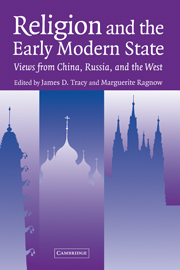Book contents
- Frontmatter
- Contents
- Contributors
- Acknowledgments
- Preface
- Religion and the Early Modern State
- Introduction
- PART I LIVED RELIGION AND OFFICIAL RELIGION
- PART II FORMS OF RELIGIOUS IDENTITY
- PART III THE SOCIAL ARTICULATION OF BELIEF
- 9 False Miracles and Unattested Dead Bodies: Investigations into Popular Cults in Early Modern Russia
- 10 Liturgical Rites: The Medium, the Message, the Messenger, and the Misunderstanding
- 11 Self-correction and Social Change in the Spanish Counter-Reformation
- 12 The Disenchantment of Space: Salle Church and the Reformation
- AN EPILOGUE AT THE PARISH LEVEL
- Selected Annotated Bibliography of Secondary Works
- Index
9 - False Miracles and Unattested Dead Bodies: Investigations into Popular Cults in Early Modern Russia
Published online by Cambridge University Press: 23 May 2010
- Frontmatter
- Contents
- Contributors
- Acknowledgments
- Preface
- Religion and the Early Modern State
- Introduction
- PART I LIVED RELIGION AND OFFICIAL RELIGION
- PART II FORMS OF RELIGIOUS IDENTITY
- PART III THE SOCIAL ARTICULATION OF BELIEF
- 9 False Miracles and Unattested Dead Bodies: Investigations into Popular Cults in Early Modern Russia
- 10 Liturgical Rites: The Medium, the Message, the Messenger, and the Misunderstanding
- 11 Self-correction and Social Change in the Spanish Counter-Reformation
- 12 The Disenchantment of Space: Salle Church and the Reformation
- AN EPILOGUE AT THE PARISH LEVEL
- Selected Annotated Bibliography of Secondary Works
- Index
Summary
TheSpiritual Regulation of 1721 embodied Peter the Great's blueprint for the perestroika of the Russian Orthodox Church. Among its many provisions outlining the public purposes of religion and establishing a new administrative structure for the Church, the Spiritual Regulation expressed concern for the problem of “superstitious practices”: wandering holy fools, klikushki (hysterical women), improbable versions of saints' lives, false reports of miracles from icons, and bogus relics. The Spiritual Regulation charged Church authorities – parish priests, local bishops, and its new central ruling body – with investigating such inappropriate popular religious observances and stamping them out. Specifically, the new edict dictated that priests inform the appropriate ecclesiastical and secular authorities if “someone imagined in some way a false miracle, or contrived it hypocritically, and then broadcast it so that the simple and unreasoning people take it for the truth.” Bishops, for their part, were to report to the Ecclesiastical College (or, as it was renamed almost immediately, the “Most Holy Governing Synod”) twice annually about the state of their eparchies, including instances of “false miracles from holy icons” and “unattested dead bodies” – that is, the relics of unofficial saints. After receiving such reports, the Synod then had the obligation to launch formal investigations of all such “apparitions” and “miracles.” Offenders would be subject not only to ecclesiastical penalties, but also to severe civil ones.
Scholars of the Petrinereforms have not previously tried to trace the methods the Russian Church hierarchy used to regulate popular religion.
- Type
- Chapter
- Information
- Religion and the Early Modern StateViews from China, Russia, and the West, pp. 253 - 283Publisher: Cambridge University PressPrint publication year: 2004



